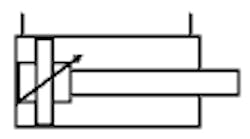Quiz on information learned from chapter 15
1. A ram cylinder can only have_________________in one direction.
- movement
- force
- rotation
2. A ram cylinder has:
- a piston with seals to guide it
- no piston or seals to guide it
- a non-sealing guide only
3. The area of a cylinder is figured with the formula:
- F=PA
- π r2
- π d2
4. Cylinder force or thrust is figured by the formula:
- F=PA
- π r2
- π d2
5. A 2:1 area ratio cylinder has a rod that is:
- half the diameter of the piston
- twice the diameter of the piston
- half the area of the piston
6. A double rod-end cylinder with the same pressure at either end can have:
- equal force and speed in both directions of travel
- higher force in one direction of travel
- either of the above
7. With the same pressure at either end a single-rod end cylinder has:
- equal force in both directions of travel
- more force extending
- more force retracting
8. Cable cylinders are:
- twice as long as their stroke
- three times as long as their stroke
- slightly longer than their stroke
9. Non-Rotating rod cylinders:
- allow no radial movement of the piston rod
- only allow some radial movement of the piston rod
- can allow a lot of radial movement of the piston rod
10. This symbol is for a:
- non-cushioned cylinder
- cushion rod end only cylinder
- cushion both ends cylinder
11. Tandem cylinders can have almost_________________the force as a single cylinder.
- twice
- three times
- four times
12. Diaphragm cylinders have:
- small area and long strokes
- large area and long strokes
- large area and short strokes
13. Always size an air cylinder with at least:
- 10% more force than required
- 25% more force than required
- 75% more force than required
14. A cylinder with an actual 2:1 rod in a regeneration circuit will:
- extend twice as fast as retract
- extend and retract at the same speed
- cannot regenerate a 2:1 rod cylinder
15. Hydraulic motors are usually rated in:
- pounds force
- lb-in., lb-ft, or Newton-meters torque
- horsepower
16. Gear on gear hydraulic motors offer:
- high-torque/low-speed output
- high-speed/low-torque output
- high-speed/nominal-torque output
17. Axial or inline piston motors offer:
- high-torque/low-speed output
- high-speed/high-torque output
- both of the above
18. Radial piston hydraulic motors offer:
- high-torque/low-speed output
- high-speed/low-torque output
- high-speed/nominal-torque output
19. Single vane rotary actuators give up to:
- 90° rotary output
- 180° rotary output
- 270° rotary output
20. This symbol is for a:
- hydraulic rotary actuator.
- pneumatic rotary actuator.
- neither of the above.



